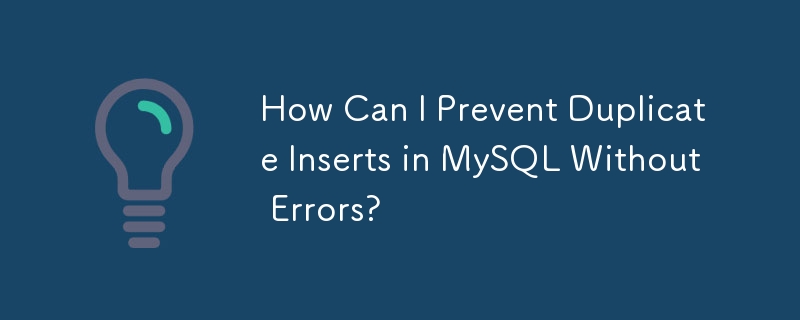Home >Database >Mysql Tutorial >How Can I Prevent Duplicate Inserts in MySQL Without Errors?
How Can I Prevent Duplicate Inserts in MySQL Without Errors?
- Susan SarandonOriginal
- 2025-01-25 03:56:08501browse

Mastering Duplicate-Proof MySQL Inserts: A Comprehensive Guide
Overview
Preventing duplicate entries when adding data to a MySQL table is crucial. While unique constraints prevent inserts of duplicate keys, managing errors arising from this in your PHP or other code requires a more sophisticated approach.
Leveraging INSERT IGNORE
The INSERT IGNORE statement offers a straightforward solution. It attempts an insertion; if a duplicate exists, the operation is silently skipped. Example:
<code class="language-sql">INSERT IGNORE INTO my_table (col1, col2) VALUES ('val1', 'val2');</code>
Employing INSERT ... ON DUPLICATE KEY UPDATE
A more flexible method is INSERT ... ON DUPLICATE KEY UPDATE. This checks for existing rows with matching keys. If found, it executes the UPDATE clause; otherwise, it performs the INSERT. Example:
<code class="language-sql">INSERT INTO my_table (col1, col2) VALUES ('val1', 'val2')
ON DUPLICATE KEY UPDATE col2 = 'val2';</code>
Here, if col1 with value 'val1' already exists, only col2 is updated. Otherwise, a new row is inserted.
Key Considerations
-
REPLACE: This command overwrites existing rows with duplicate keys. Use cautiously! -
Testing: Always test queries without
IGNOREto identify other potential issues. -
Efficiency:
INSERT ... ON DUPLICATE KEY UPDATEcan be less efficient if theUPDATEdoesn't modify any columns. - Indexing: Indexes on unique columns significantly speed up duplicate checks.
This guide provides robust strategies for handling duplicate inserts in MySQL, ensuring data integrity and efficient code execution.
The above is the detailed content of How Can I Prevent Duplicate Inserts in MySQL Without Errors?. For more information, please follow other related articles on the PHP Chinese website!

